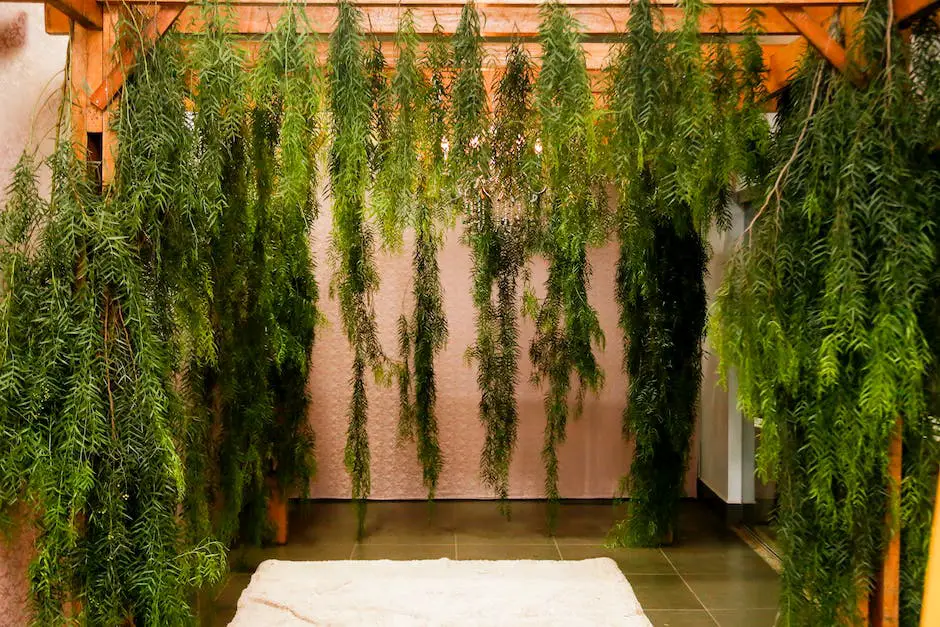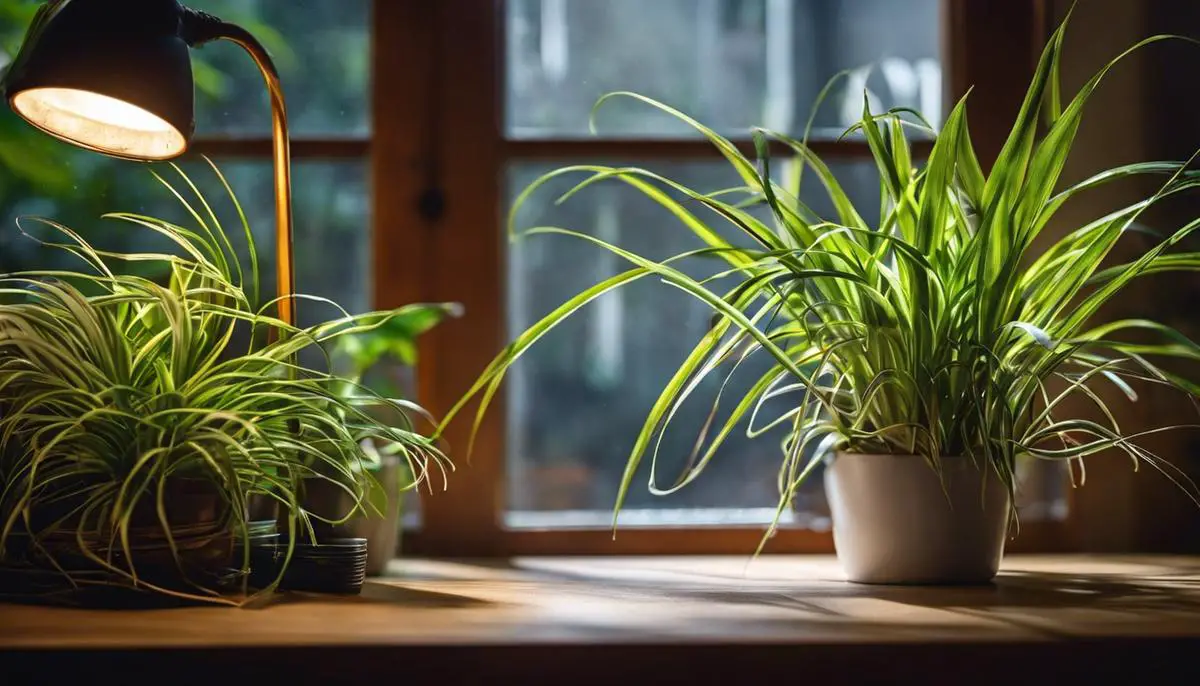From adding a touch of greenery to enhancing the overall aesthetics of a space, the humble spider plant has charmed many homeowners with its resilient nature and easy maintenance. Individuals seeking to hang these plants at home effectively will appreciate advice on procuring the right spot, accumulating essential tools, and implementing optimum hanging techniques. Let’s unravel the mysteries of hanging spider plants by first focusing on finding the perfect spot for them, carefully considering aspects such as light exposure, humidity, and space, all of which are crucial for the plant’s well-being and growth.
Finding the Perfect Spot for your Spider Plant
Remember those lovely spider plants you grew out of your window in college dorm rooms, or perhaps in ceramic pots on your office desk? With their cascading, variegated leaves, these hardy green wonders are timeless beauties that add life and freshness to our homes. Fast forward a few years, and now, as a busy parent, you may be wondering how to incorporate these houseplants into your family’s space. No worries! Let’s walk step-by-step through the process of identifying the ideal spot for hanging a spider plant in your home.
First and foremost, it’s essential to remember that spider plants prefer bright, indirect light. They can also adapt well to semi-shaded areas, making them incredibly flexible. However, strong direct sunlight can cause the leaves to scorch and lose their treadmark variegation. So, areas close to north-facing windows or a few feet away from east- or west-facing windows would serve your spider plant well.
Next, think about temperature and air quality. Spider plants don’t enjoy chilly conditions. Rooms that maintain a temperature of 60–75°F are ideal. Essentially, if it’s comfortable for your family, it’s likely comfortable for your spider plants too. They also love fresh air but are not fans of drafty places. Therefore, avoid hanging them near air conditioning vents, radiators, or drafty windows.
Always keep in mind the plant’s cascading growth pattern when choosing a spot. That sunlit corner with a high shelf would be a great choice, offering the plant ample space to display its beautiful trailing leaves. Even consider hanging spots around your ceiling as tantalizing decor, perhaps above the dining area or in the living room. Beautiful and natural décor—who could ask for more?
Don’t forget about ease of care! Spider plants still need your tender love and care, despite their hardy nature. They should be reachable for regular watering and occasional pruning. Ensure the chosen spot doesn’t make these tasks feel like a tedious chore.
Let’s talk humidity now. Spider plants prefer moderate-to-high humidity levels. Hence, spots near your kitchen or bathroom could be considered, as they tend to have higher humidity levels. However, ensure that the plant doesn’t get splashed with water during your cooking or showering routine.
Lastly, as parents, always ensure that houseplants are hung in a spot that is out of reach of small children and pets. Even though spider plants are non-toxic, the dangling leaves might be too tempting for curious toddlers or playful cats!
Plants not only bring elements of nature into your home but also help build an environment of calm and tranquility, something every family could use a little more of. With these tips, finding the perfect spot to hang your spider plant should be a breeze. Now, get ready to enjoy this lovely addition to your family’s space. Happy decorating, and even happier parenting!

Photo by chuabingquan
Assembling Necessary Tools and Materials
Crucial Tools and Materials for Hanging Your Spider Plant
Now that you’ve carefully selected the perfect spot for your spider plant, it’s time to gather the right tools and materials to hang it successfully. After all, creating a cozy and green living space for you and your family involves more than just choosing the plant; it’s about maintaining this live décor in a thriving state.
The first tool you’ll need is a high-quality plant hanger. You want to ensure that your precious spider plant stays safe and stable. A sturdy macramé plant hanger is a delightful choice that combines beauty and durability. It’s not just a practical tool—it’s a decorative feature that adds texture and a dash of bohemian charm.
Next in line would be a durable hook and anchor combination. These are vital for securely suspending your plant from the ceiling. When choosing these, keep in mind the approximate weight of your plant when watered to ensure your hook can support it. You’ll also need a drill to install the hook on your ceiling.
Another essential item is a substantial hanging pot. Consider options fabricated with lightweight materials such as plastic or resin to keep the total weight manageable. Ensure the pot has proper drainage to prevent waterlogging, which can be detrimental to your spider plant’s health.
Your spider plant may occasionally need repotting as it grows, so having high-quality potting soil on hand is vital. Look for a well-draining potting mix with perlite to prevent waterlogged soil.
In terms of a watering tool, opt for a long-spouted watering can. It will make watering your hanging spider plant a breeze. This way, you’ll avoid not only a mess but also overwatering your plant with more precise watering.
When designing a nurturing home environment, we shouldn’t forget about maintaining the health of our plants. Therefore, have on hand a safe, mild houseplant fertilizer. Use this sparingly according to the package directions to ensure your spider plant gets the necessary nutrients to thrive.
Last but not least, given the spider plant’s preference for high humidity levels, a spray bottle for misting your plant is a great tool, especially during drier months. It’s also a fun and engaging way for children to participate in caring for household plants.
In conclusion, hanging your spider plant with the right tools and materials not only ensures that it thrives in your home but also engenders a sense of accomplishment and connectedness to nature. There’s something truly rewarding about facilitating growth, be it in our children, our relationships, or our lush, leafy friends. Embrace the process and enjoy the serene, vibrant atmosphere that a well-tended spider plant brings to your home.

Photo by Abely Costa
Hanging Techniques for Spider Plants
Harnessing the Beauty of Spider Plants: The Art of Plant Hanging
Once you have nestled your spider plant in the perfect spot, taking into consideration its growth pattern, light preferences, and the ideal home environment, it’s time for the hands-on fun part—the actual hanging process.
We’ll talk about everything you’ll need to make sure your spider plant is not only healthy but also displayed in a way that enhances the aesthetic of your home.
The first item on the list would be the plant hangers. There are a plethora of stylish and functional plant hangers to choose from. Macramé hangers are trendy while offering a classic, timeless appeal. Another option is a more structured wire or metal hanger, which can complement a sleek, modern home design.
Next come hooks and anchors. These play an integral role in securing your plant. When shopping for hooks and anchors, keep in mind the weight and size of the fully grown plant, plus the weight of the water-filled pot. Durability is key here. Screw-in ceiling hooks tend to be robust and reliable.
Now, depending on your chosen spot, you might need to drill holes for the hooks. Don’t be daunted by this task! It’s surprisingly simple; just make sure you’re drilling into a stud and not just thin air! A handheld drill and a steady hand are all you need.
Selecting your spider plant’s “home” is another fun task. The right hanging pot should showcase your plant while adhering to its drainage needs. Speaking of which, consider a pot that has holes at the bottom to prevent waterlogging. Pair it with a cute ceramic drip tray to catch any excess water.
The specifics of repotting boil down to potting soil. Go for a well-draining, loose-potting mix. It’s even better if it’s enriched with slow-release fertilizers that will provide your plant with nutrients over time.
Investing in long-spouted watering can allow for more control as you water those hard-to-reach hanging plants. You want to ensure the roots get water, and the long spout makes it easier to reach inside without making a mess!
Speaking of feeding your plants, houseplant fertilizers are a must-have for any indoor gardener. Consider a balanced, water-soluble fertilizer that you mix right into the watering can. It’s like a multi-vitamin, but for your plants!
In addition, your spider plant will be grateful for a spray bottle for misting. Spider plants thrive in humid environments, and being suspended in the air, they can dry out quickly. Regular misting with a spray bottle keeps them hydrated and brings a refreshing, natural feel to your living space. Plus, it helps keep the leaves clean and dust-free!
Finally, remember to keep tabs on your spider plant’s health. Yellow or wilting leaves signal a cry for help! Maintain a consistent watering schedule, adjust sunlight exposure, and keep an eye on the temperature.
Mastering the art of hanging a spider plant might take some time and research. But when you see those iconic long, arching leaves cascading down, enhancing your living space’s aesthetic appeal, you’ll realize it’s all so worth it.

By now, you should have a fair idea of how to navigate through the process of hanging spider plants. From locating the best position in your home, acquiring all necessary tools and materials, and familiarizing yourself with different hanging techniques that validate your plant’s safety and aesthetics,. The art of hanging a spider plant is one of patience, care, and knowledge. As you practically implement these insights, you will indeed reap the rewards of having a thriving and beautifully situated spider plant, accentuating your home’s aesthetics and bringing in a splash of nature’s soul.




